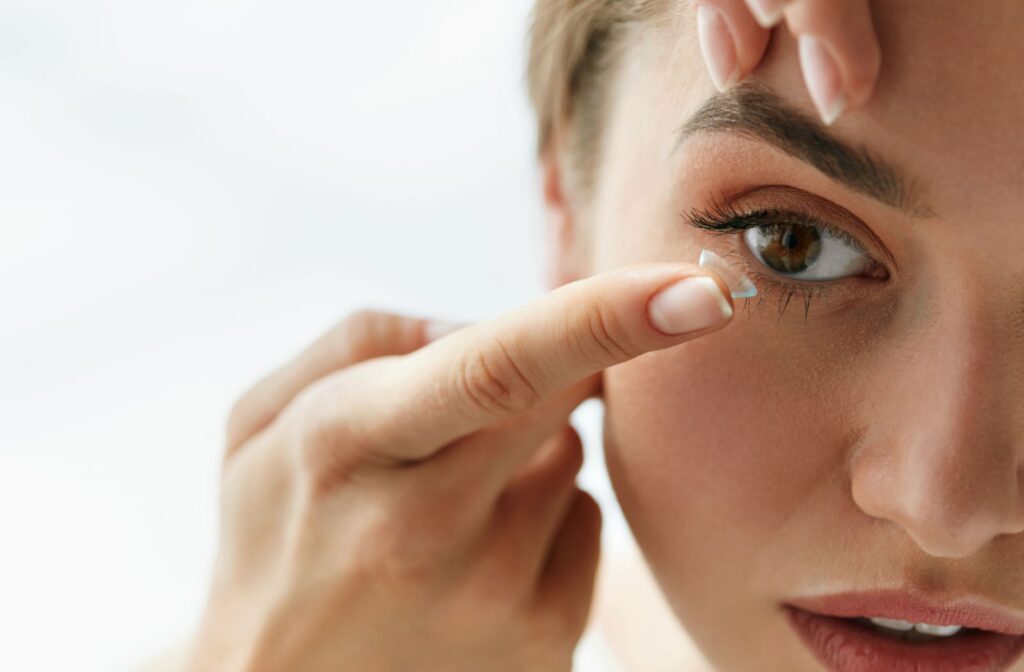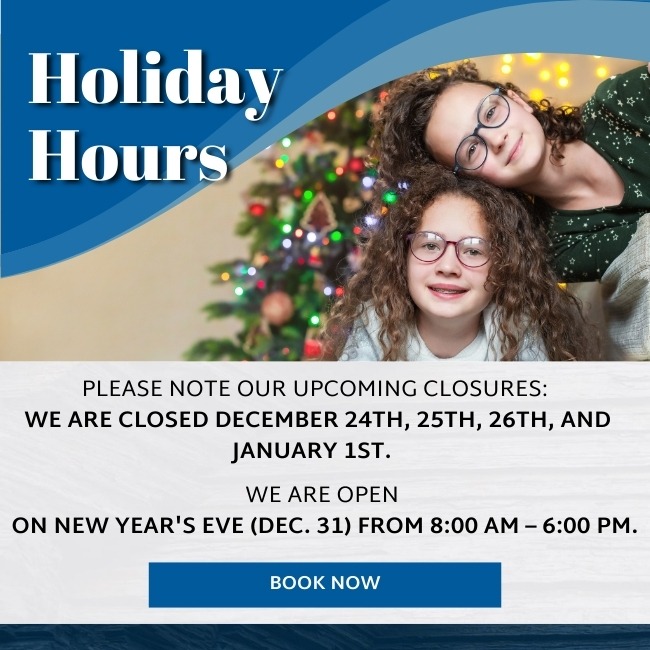Contact lenses can be a convenient option for vision correction, but they require a specialized exam and fitting to get the right lens for your unique eyes. What exactly goes on during a lens fitting, and why is it an essential step in achieving comfortable and clear vision for all fellow contact wearers?
Here is what you can expect:
- Your eye doctor will take measurements of your cornea and pupil size to determine the correct size and shape of lens you’ll need.
- Your eye doctor will evaluate the health of your eyes, looking for any signs of dryness or irritation. They may perform a tear film evaluation to see if you have enough natural moisture in your eyes to support contact lens wear.
- You will be guided through properly inserting and removing the lenses from your eye. This step is essential to help you avoid discomfort and infection.
- You’ll be given trial lenses to wear for a short period to see how you and your eyes adjust to wearing contact lenses.
- You’ll be able to ask any questions or raise concerns about contact lenses.
Finding the perfect pair of contacts may take some trial and error, but there are many types of lenses, and likely one to suit your needs.
The Importance of Regular Eye Exams for Contact Lens Wearers
Contact lens wearers should see their eye doctor for a routine exam more frequently than others because:
- Your vision may change. Regular eye exams help ensure that your prescription is current and that your lenses provide the correct vision correction.
- Your fit may change. Contacts require a proper fit to ensure comfort and clear vision, so this exam gives you time to adjust your lens type or wear schedule.
- Your eye health will be monitored. Contact lenses increase your risk of dryness, infections, or corneal damage. Eye exams include comprehensive eye health checks to detect problems early.
- You’ll get a refresher on proper handling, storage, and usage. Good hygiene practices and lens care help minimize the risk of complications associated with wearing contact lenses.
Preparing for the Appointment
Every appointment is slightly different, but here are some tips for going to your contact lens exam prepared:
- Bring your current contact lenses and prescription. Your eye doctor may want to compare them to the new ones they prescribe.
- Have a list of any medications you are taking and any allergies or medical conditions. These can all impact your eye health and vision.
- Be ready to discuss your lifestyle and needs. Do you play sports? Work at a computer all day? Your eye doctor will take this into account when prescribing contacts.

Eye Measurements & Evaluation
A lens fitting involves detailed measurements of your unique eyes so your eye doctor can recommend the right shape, style, and lens brand for your needs.
We use various technologies to accurately determine your level of vision correction, internal eye pressure, and eye muscle control.
Corneal Shape
Your cornea is the clear, dome-shaped surface at the front of your eye. Its shape is crucial in how light is focused onto your retina (the back of your eye). During a contact lens fitting, we will measure the curvature and size of your cornea to ensure that your lenses fit comfortably and provide optimal vision correction.
Contact lenses should sit snugly on the cornea to provide clear vision without causing discomfort or irritation.
Pupil & Iris Size
The pupil is the black, circular opening in the center of your iris (the coloured part of your eye). It controls the amount of light that enters your eye. During a contact lens fitting, we will measure both your pupil and iris size to ensure that the lenses provide adequate coverage.
This is especially important for those with larger or smaller than average pupils, as it can affect how much of the contact lens is exposed and how well you can see.
Vision Correction Needs
Whether you are nearsighted, farsighted, or have astigmatism, we will carefully assess your vision correction needs during a contact lens fitting. We will also ask about any symptoms you may be experiencing with your current glasses.
Types of Lenses
There are many types of contact lenses available for all different types of needs, lifestyles, and preferences, including:
- Soft contact lenses: These are made of a soft, flexible plastic material and are the most commonly prescribed type of contact lens. They come in various types, such as daily wear, extended wear, and overnight wear.
- Rigid gas-permeable (RGP) lenses: These are made of a rigid plastic material that allows oxygen to pass through to the cornea. They provide sharper vision but may take some time to get used to.
- Hybrid contact lenses: These lenses have a hard center and a soft outer ring for added comfort. They can be helpful for those with certain conditions like astigmatism.
- Scleral contact lenses: These are large-sized lenses that also cover the white part of the eye. They are typically recommended for those with irregular corneas or severe dry eye.
- Specialty lenses: These lenses have specific designs for specific needs, such as correcting vision for those with keratoconus or slowing myopia progression.
Lens Training & Trial
Many people struggle with contact lenses when they’re first prescribed for them. We’ll teach you different techniques for inserting and removing them and will make sure you’re comfortable with this process before you leave the office. We’ll also show you how to care for your contact lenses and recommend products like saline solution or rewetting drops.
We also provide training videos on our website if you need a refresher.
Before the end of your appointment, you’ll be given a set of trial lenses. This step is crucial for allowing you to try out the lenses and ensure they are comfortable and fit properly before committing to an entire supply.
Get Ready to Explore the Clarity of the World
If you’re ready to try contact lenses, call us today to book your appointment with our Maple Ridge Eye Care team. We’ll help you find the perfect lenses for your lifestyle and answer any questions.


